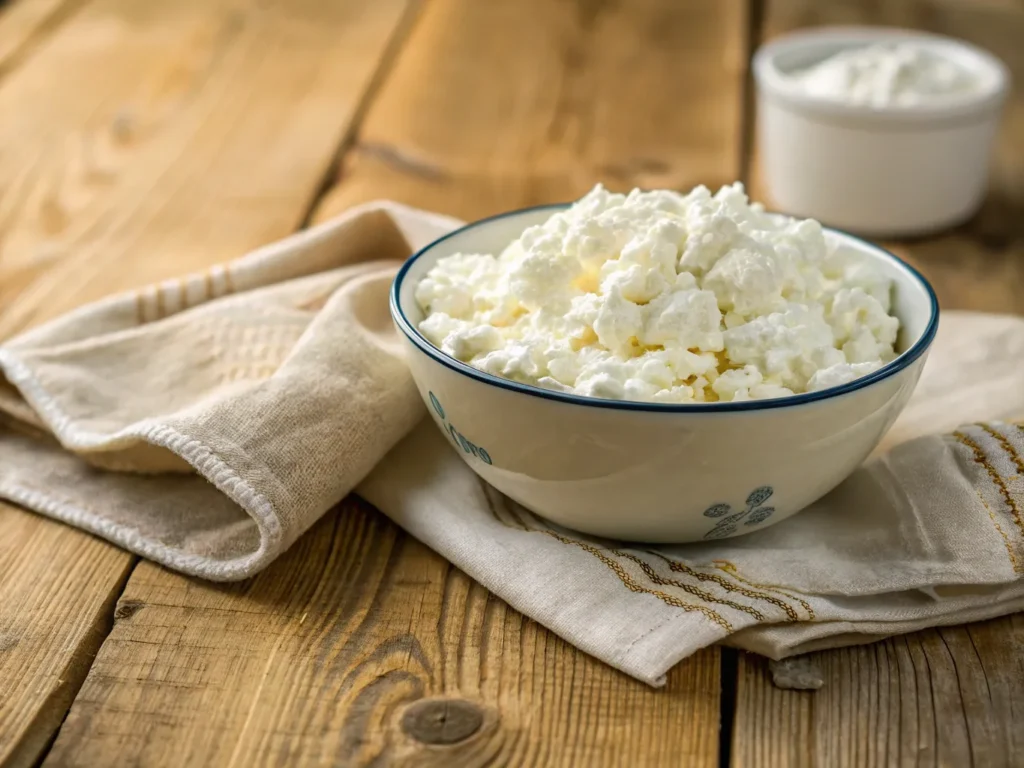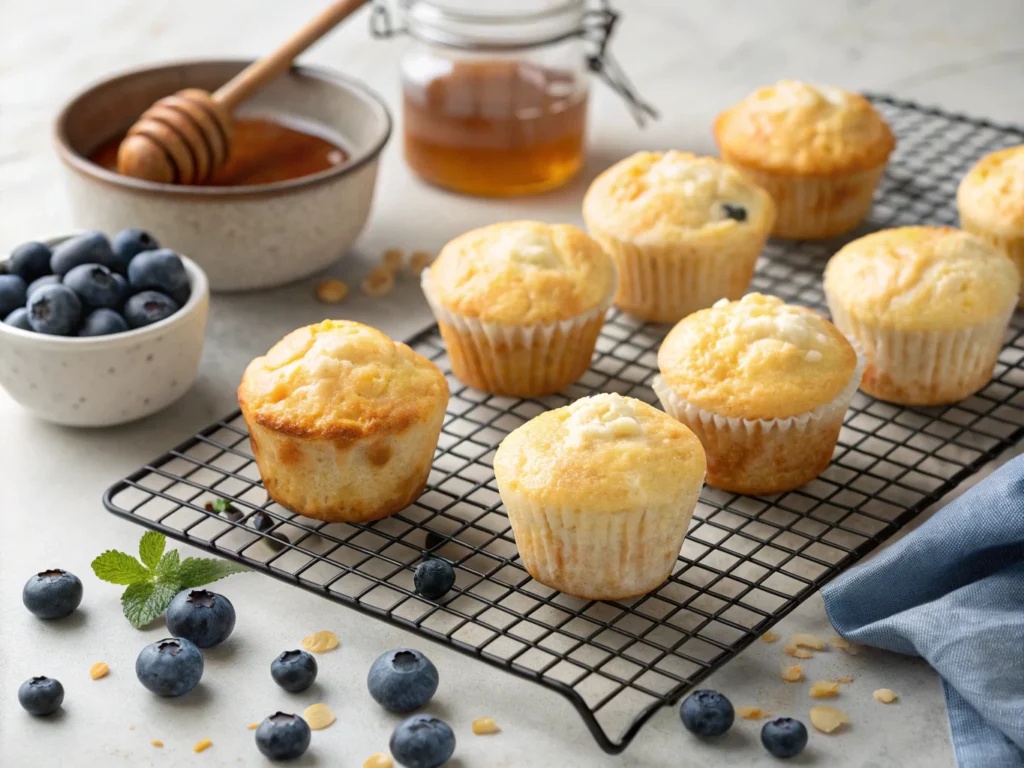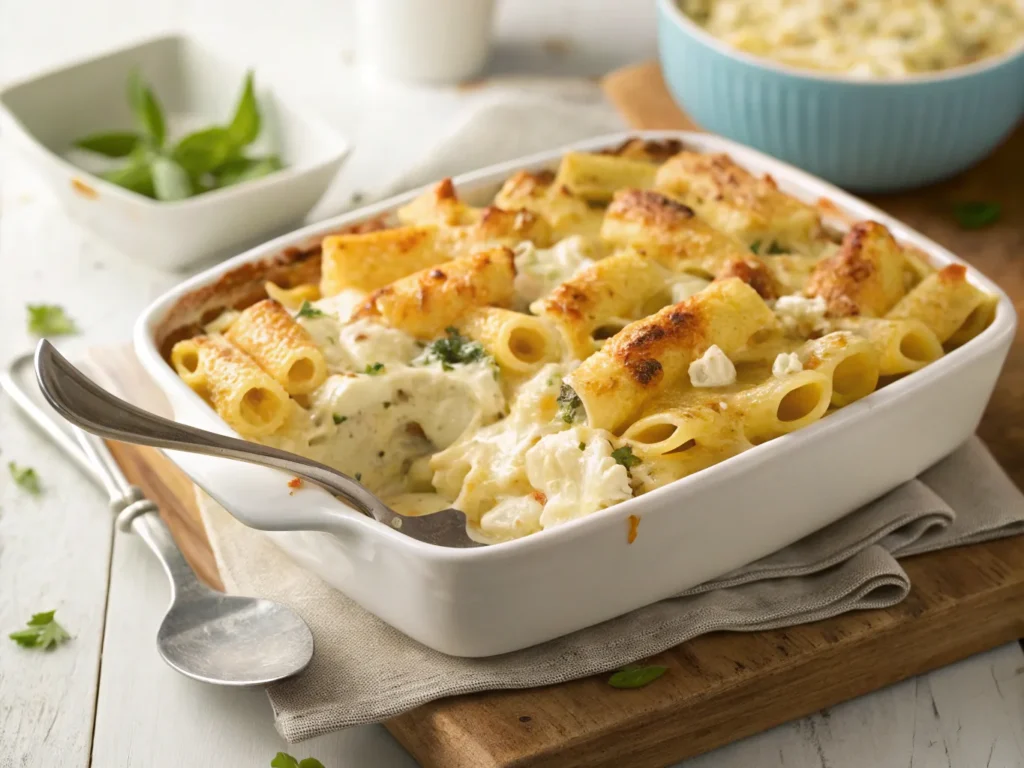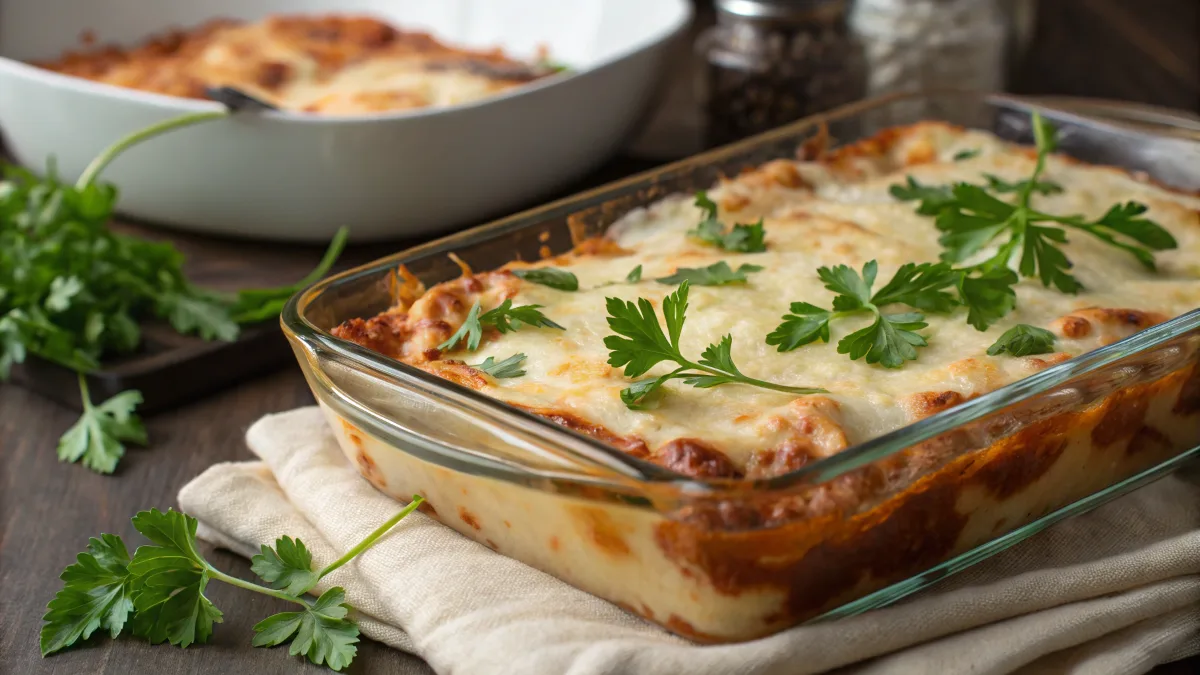Introduction
Cottage cheese is a go-to ingredient for health enthusiasts and culinary adventurers alike. But have you ever wondered whether it’s safe to bake cottage cheese? This question arises often due to the unique texture and high moisture content of this creamy cheese. In this comprehensive guide, we’ll explore the safety and benefits of baking cottage cheese, answer common questions, and share tips and recipes to help you make the most of this nutritious ingredient. Whether you’re baking lasagna or whipping up a protein-packed dessert, we’ve got you covered!
Table of Contents
The Safety of Baking Cottage Cheese
Cottage cheese is a popular ingredient, but when it comes to baking, some concerns about safety and proper usage may arise. Let’s break down why it’s safe to bake cottage cheese, and how you can do it the right way.
Is It Safe to Bake Cottage Cheese?
Yes, it’s entirely safe to bake cottage cheese. This type of cheese is made by curdling milk and is perfectly safe for cooking and baking when handled properly. Baking doesn’t compromise its safety; in fact, the heat helps enhance its creamy texture and blends it seamlessly into dishes.
However, there are a few things to consider:
- Freshness Matters: Always use fresh The cheese. Check the expiration date and ensure it’s been stored at the proper temperature (below 40°F or 4°C).
- No Harmful Additives: Opt for plain cottage cheese without artificial additives or preservatives that might not fare well when heated.

Golden-baked cottage cheese muffins with a hint of sweetness.
Safety Tips for Baking Cottage Cheese
To ensure your dishes turn out safe and delicious when you bake cottage cheese, follow these tips:
- Check the Packaging
- Look for any signs of spoilage, such as an unusual smell or discoloration, before using the cheese.
- Avoid using cottage cheese if the seal on the packaging is broken or tampered with.
- Bake at Moderate Temperatures
- Baking cottage cheese at very high temperatures may cause the curds to separate excessively, creating a grainy texture. Stick to moderate baking temperatures, such as 325°F to 375°F (160°C to 190°C).
- Handle with Clean Utensils
- Cross-contamination is a safety hazard. Use clean spoons, bowls, and utensils when handling cottage cheese to maintain its quality and safety.
- Strain the Cheese if Necessary
- Cottage cheese has a high water content, which may release liquid during baking. If your recipe requires a thicker texture, strain the cheese using a cheesecloth or fine-mesh sieve.
Why Freshness of cottage chees Is Key
Baking enhances the flavors and textures of cottage cheese, but only if it’s fresh. Expired or spoiled cottage cheese may develop harmful bacteria, which could compromise both the safety and taste of your dish. Always check for signs of spoilage, including:
- A sour or foul smell.
- A change in texture, such as clumps that are excessively slimy.
- Mold on the surface of the cheese.
By following these safety precautions, you can confidently bake with cottage cheese and elevate your recipes to new levels of flavor and nutrition.
Benefits of Baking Cottage Cheese
Baking with cottage cheese isn’t just safe—it’s also a great way to enhance your dishes while reaping its many nutritional benefits. Whether you’re looking for a healthier alternative to traditional ingredients or simply want to experiment with flavors, cottage cheese is a versatile option that delivers in both taste and health.
To ensure your baked cottage cheese dishes are both safe and delicious, always start with fresh cottage cheese. Check the expiration date and make sure it’s stored at the proper temperature. If you’re unsure how to maintain its freshness, here’s a helpful guide on how to properly store cheese.
Why Choose Cottage Cheese for Baking?
Cottage cheese is more than just a diet-friendly snack; it’s a powerhouse ingredient for bakers. Here’s why many choose to bake cottage cheese into their recipes:
- Nutritional Value of cottage chees
- Cottage cheese is high in protein, making it an excellent addition to meals, especially for those looking to increase their protein intake.
- It’s a rich source of calcium, which promotes strong bones and teeth.
- Low in calories and fat (especially in reduced-fat varieties), cottage cheese is ideal for health-conscious individuals.
- Flavor Flexibility
- Cottage cheese has a mild, tangy flavor that blends well with both savory and sweet dishes. Its adaptability allows it to replace ingredients like ricotta or cream cheese in recipes.
- Enhances Texture
- When baked, cottage cheese softens to create a creamy, smooth texture. This makes it perfect for dishes like lasagna, casseroles, or even cheesecakes.
Health Benefits of Baking Cottage Cheese
Baking cottage cheese not only maintains its nutritional integrity but can also amplify its appeal:
- High Protein Content
- Baking with cottage cheese is a great way to add protein to your meals. Just one cup of cottage cheese can provide up to 25 grams of protein, helping you feel full longer and supporting muscle repair.
- Low in Carbs
- Cottage cheese is naturally low in carbohydrates, making it a suitable option for low-carb or keto-friendly recipes.
- Digestive Benefits
- Cottage cheese contains probiotics (in some varieties) that support gut health. When baked, these beneficial bacteria may be reduced, but you’ll still enjoy other digestive benefits from its easy-to-digest protein.

Creamy cottage cheese pasta bake topped with fresh basil.
Cottage Cheese as a Healthy Substitute
One of the best things about cottage cheese is its versatility in baking. Here are a few ways to use it as a healthy substitute:
- Replace Ricotta
- Swap ricotta for cottage cheese in lasagna or stuffed shells for a lighter, protein-packed alternative.
- Use in Cheesecakes
- Cottage cheese can replace cream cheese in cheesecake recipes, cutting calories without sacrificing creaminess.
- Add Creaminess to Sauces
- Blend cottage cheese with seasonings to create a creamy sauce that pairs perfectly with baked dishes.
Eco-Friendly Choice
Cottage cheese is less resource-intensive to produce compared to harder cheeses, making it a more sustainable choice for eco-conscious cooks.
If you’re excited to try baking with cottage cheese, there are plenty of recipes to explore. From savory dishes like lasagna to sweet treats like cheesecakes, cottage cheese is an incredibly versatile ingredient. For more inspiration, check out these cottage cheese recipes.
How Cottage Cheese Behaves When Baked
Cottage cheese is unique among cheeses due to its curd-like structure and high moisture content. When baked, it undergoes interesting transformations that can elevate your dishes. Understanding how it behaves when exposed to heat can help you make the most of this versatile ingredient.
Does Cottage Cheese Melt When Baked?
No, cottage cheese does not melt like mozzarella or cheddar. When you bake cottage cheese, it softens and creates a creamy consistency, adding unique texture to dishes like lasagna and casseroles:
- Curds Retain Their Shape: The small curds in cottage cheese are structured to hold together even under heat. This gives baked dishes a delightful texture that’s both creamy and slightly chewy.
- Moisture Release: Instead of melting, cottage cheese releases moisture during baking. This can add creaminess to dishes but may also require adjustments to avoid excessive liquid.
Why Does Cottage Cheese Get Watery When Cooked?
Cottage cheese has a naturally high water content, which often leads to liquid release during baking. To solve this when you bake cottage cheese, consider:
Here’s how to address the issue:
- Strain Before Use
- Use a cheesecloth or fine-mesh sieve to remove excess liquid from the cottage cheese before adding it to your recipe.
- Add a Thickening Agent
- Mix cottage cheese with cornstarch or flour to help absorb excess moisture during baking.
- Combine with Other Ingredients
- Blending cottage cheese with eggs or cream before baking can stabilize its texture and prevent water separation.

How Baking Affects Flavor and Texture
Baking transforms the flavor and texture of cottage cheese in a way that complements many recipes:
- Enhanced Flavor: The mild tanginess of cottage cheese becomes subtler when baked, allowing it to meld beautifully with other ingredients.
- Creamier Consistency: While the curds don’t melt, they soften under heat, creating a creamy mouthfeel.
- Golden Crust: Cottage cheese can achieve a light golden color when baked, adding an appetizing finish to dishes like lasagna or casseroles.
Ideal Baking Techniques for Cottage Cheese
To get the best results when baking cottage cheese, follow these techniques:
- Blend for Smoothness
- If you prefer a silky texture, blend the cottage cheese before adding it to your recipe. This works especially well for cheesecakes or sauces.
- Bake at Moderate Temperatures
- Avoid high heat, as it can cause the curds to separate excessively. Stick to a range of 325°F to 375°F for even cooking.
- Layer Strategically
- For layered dishes like lasagna, spread the cottage cheese evenly to prevent pockets of moisture.
Recipes That Use Baked Cottage Cheese
Cottage cheese is a star ingredient in countless baked cottage cheese recipes, thanks to its creamy texture and mild flavor. Whether you’re preparing savory meals or indulging your sweet tooth, there are many ways to incorporate cottage cheese into your baked creations. Below are some popular recipes that showcase the versatility of baked cottage cheese.
Baked cottage cheese dishes make excellent leftovers, but proper storage and reheating are key to preserving their flavor and texture. For more meal ideas that pack in flavor and nutrients, don’t miss these high-protein meals.
Savory Recipes Featuring Cottage Cheese
- Cottage Cheese Lasagna
A lighter alternative to traditional lasagna, where you can easily bake cottage cheese into layers for a protein-packed meal.- How to Make It:
- Spread a layer of strained cottage cheese between sheets of lasagna noodles.
- Add layers of marinara sauce, ground beef, and shredded mozzarella.
- Bake at 375°F (190°C) for 40-45 minutes until bubbling and golden.
- How to Make It:
- Vegetable Cottage Cheese Casserole
This dish combines the goodness of veggies with the creaminess of cottage cheese for a nutrient-packed meal.- How to Make It:
- Mix steamed broccoli, carrots, and cauliflower with cottage cheese and shredded cheddar.
- Add a sprinkle of breadcrumbs on top for crunch.
- Bake at 350°F (175°C) for 30 minutes until golden.
- How to Make It:
- Baked Cottage Cheese Stuffed Peppers
Bell peppers stuffed with cottage cheese and quinoa make for a healthy and satisfying dinner.- How to Make It:
- Hollow out bell peppers and stuff them with a mixture of cottage cheese, cooked quinoa, diced tomatoes, and spices.
- Bake at 375°F (190°C) for 25 minutes.
- How to Make It:
Sweet Recipes Using Cottage Cheese
- Cottage Cheese Cheesecake
A lighter twist on the classic cheesecake, this recipe swaps cream cheese for cottage cheese, making it perfect for calorie-conscious dessert lovers.- How to Make It:
- Blend cottage cheese until smooth, then mix it with eggs, sugar, and vanilla extract.
- Pour the mixture over a graham cracker crust.
- Bake at 325°F (160°C) for 50 minutes or until set.
- How to Make It:
- Cottage Cheese Muffins
These protein-packed muffins are ideal for breakfast or a midday snack.- How to Make It:
- Combine strained cottage cheese with eggs, whole wheat flour, honey, and a dash of cinnamon.
- Add optional mix-ins like blueberries or chocolate chips.
- Bake at 375°F (190°C) for 18-20 minutes.
- How to Make It:
- Baked Cottage Cheese Pancakes
Turn pancakes into a baked treat by using cottage cheese for added fluffiness and flavor.- How to Make It:
- Blend cottage cheese, eggs, and oats until smooth.
- Pour the batter into a greased baking dish and top with fresh fruit.
- Bake at 350°F (175°C) for 20-25 minutes.
- How to Make It:

Creamy cottage cheese pasta bake topped with fresh basil.
Why Baked Cottage Cheese Recipes Work
The key to the success of baked cottage cheese recipes lies in the balance of flavors and textures. The natural creaminess of cottage cheese adds richness to both savory and sweet dishes, while its high protein content makes meals more filling and nutritious.
Tips for Baking with Cottage Cheese
Baking with cottage cheese can elevate your dishes to a whole new level. Its versatility, creamy texture, and nutritional value make it a go-to ingredient for both savory and sweet recipes. To ensure success, follow these tips for baking with cottage cheese.
1. Use Full-Fat Cottage Cheese for Better Results
While low-fat and non-fat varieties of cottage cheese are great for calorie-conscious eaters, full-fat cottage cheese provides better results in baked recipes:
- Improved Texture: Full-fat cottage cheese creates a richer, creamier consistency in baked dishes.
- Enhanced Flavor: The slightly tangy taste is more pronounced and complements other ingredients better.
2. Strain the Cottage Cheese
To avoid watery dishes, always strain cottage cheese before adding it to your recipe. Here’s how:
- Place a fine-mesh sieve or cheesecloth over a bowl.
- Add the cottage cheese and let it sit for 15-30 minutes to remove excess moisture.
- Gently press with a spoon to extract additional liquid, if needed.
3. Blend for a Smooth Texture
If you prefer a creamy texture in your baked goods, blending cottage cheese is a game-changer. This is especially useful for recipes like cheesecakes, sauces, or baked dips:
- Use a blender or food processor to puree the cottage cheese until smooth.
- Add ingredients like eggs, cream, or seasonings to enhance flavor and consistency.
4. Pair with Complementary Ingredients
Cottage cheese works well with a variety of ingredients. Pair it with the right flavors for a balanced dish:
- Savory Recipes: Use garlic, herbs like thyme and parsley, or spices like paprika and chili flakes.
- Sweet Recipes: Combine with vanilla, cinnamon, or fruits like berries, bananas, or apples.
5. Incorporate Binding Agents
To stabilize cottage cheese in baked recipes, add binding agents like:
- Eggs: Help hold the curds together in savory dishes.
- Flour or Cornstarch: Absorb moisture and create a smooth, thick texture.
- Cheese Blends: Pair cottage cheese with melting cheeses like mozzarella or cheddar for casseroles and lasagnas.
6. Bake at Moderate Temperatures
Cottage cheese is best baked at moderate temperatures to prevent curd separation and ensure even cooking:
- Stick to 325°F to 375°F (160°C to 190°C).
- For longer baking times, cover your dish with foil to retain moisture and prevent the top from drying out.
7. Experiment with Layering
For layered dishes like lasagna or casseroles, cottage cheese adds a creamy texture between layers:
- Spread an even layer of strained cottage cheese on top of pasta or vegetables.
- Add a sprinkle of grated Parmesan or breadcrumbs for extra flavor and a golden crust.
8. Store and Reheat Properly
Baked dishes with cottage cheese can be stored for later use. Follow these tips for the best results:
- Refrigeration: Store leftovers in an airtight container for up to 3-4 days.
- Reheating: Reheat in the oven at a low temperature (around 300°F) to preserve the texture and prevent overcooking.
By following these tips, you’ll unlock the full potential of cottage cheese in your baked recipes. From creamy casseroles to light cheesecakes, this ingredient is as versatile as it is delicious.
FAQs About Baking Cottage Cheese
Is It Good to Cook Cottage Cheese?
Yes, it’s great to bake cottage cheese! It blends beautifully into recipes, enhancing both flavor and texture while retaining its nutritional benefits. When cooked or baked:
Cottage cheese softens, blending well into both savory and sweet dishes.
It retains its high protein and calcium content, making it a nutritious addition to meals.
Cooking also allows you to experiment with a variety of recipes, from casseroles to cheesecakes.
Why Does Cottage Cheese Get Watery When Cooked?
The watery nature of cottage cheese comes from its high moisture content. When exposed to heat, the liquid separates from the curds, leading to a watery consistency. To prevent this:
Strain the Cheese: Use a fine mesh sieve or cheesecloth to remove excess moisture before baking.
Mix with a Thickener: Adding cornstarch or flour to your cottage cheese mixture can help absorb the liquid.
Pair with Low-Moisture Ingredients: Combine cottage cheese with ingredients like eggs, breadcrumbs, or starchy vegetables to balance the moisture.
Can Cottage Cheese Be Used in Baking?
Absolutely! You can bake cottage cheese into lasagna, cheesecakes, muffins, or even savory stuffed peppers for delicious results.. Some popular ways to use it include:
As a Ricotta Substitute: Use it in lasagna, stuffed pasta shells, or savory pies.
In Sweet Recipes: Cottage cheese makes cheesecakes, muffins, and pancakes lighter and healthier.
For Sauces: Blended cottage cheese can add creaminess to baked pasta or casserole dishes.
Does Cottage Cheese Melt When Baked?
No, cottage cheese does not melt like traditional cheeses such as cheddar or mozzarella. Instead, it softens, creating a creamy texture without losing its curd-like structure. This makes it ideal for dishes like:
Lasagna: Where the cheese binds layers without becoming overly gooey.
Casseroles: Adding creaminess to the dish while maintaining some texture.
Cheesecakes: Where it blends smoothly when pureed but doesn’t liquefy.
How Can I Make Cottage Cheese Less Watery for Baking?
If you’re concerned about watery cottage cheese ruining your recipe, follow these tips:
Drain Excess Liquid: Strain the cheese for 15-30 minutes using a cheesecloth.
Blend the Cheese: Processing cottage cheese into a smooth paste can reduce visible moisture and improve consistency.
Adjust Baking Ingredients: Incorporate binding agents like eggs, flour, or breadcrumbs to absorb excess liquid during baking.
What Are the Best Dishes to Bake with Cottage Cheese?
Cottage cheese is perfect for a variety of dishes. Some popular baked recipes include:
Savory: Lasagna, quiches, stuffed peppers, and baked pasta dishes.
Sweet: Cheesecakes, muffins, and baked pancake casseroles.
Protein Snacks: High-protein savory muffins or baked egg bites.
Cottage cheese often raises questions when used in baking due to its unique properties. Below, we’ve answered some of the most common queries to help you confidently bake with this versatile ingredient.
Conclusion
Baking with cottage cheese is a safe, creative, and nutritious way to enhance your favorite dishes. From savory casseroles to sweet cheesecakes, there are countless ways to bake cottage cheese into recipes that satisfy your taste buds and boost your health.. By following the tips in this guide—like straining the cheese, blending for smoothness, and using complementary ingredients—you can avoid common pitfalls and create perfectly baked dishes every time.
If you’ve been hesitant to try baking with cottage cheese, now is the perfect time to dive in. Its creamy texture, mild flavor, and high protein content make it a must-have ingredient for both sweet and savory recipes. So grab your apron, preheat the oven, and enjoy the endless possibilities of baking with cottage cheese!

